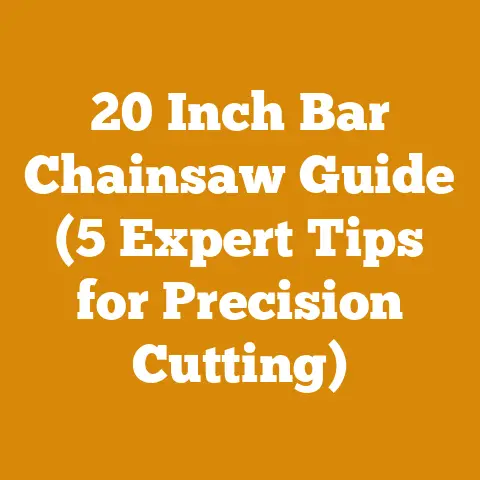When Is the Best Time to Trim Crabapple Trees? (Pro Arborist Tips)
Ah, the scent of freshly cut wood, the hum of a well-tuned chainsaw, and the satisfying thud of a log splitting in two – these are the memories that fuel my passion for all things wood. I remember spending countless hours with my grandfather in his workshop, learning the intricacies of wood processing and firewood preparation. Those early experiences instilled in me a deep respect for the craft and a desire to share my knowledge with others. Today, I’m excited to guide you through the best time to trim crabapple trees, sharing pro arborists tips I’ve learned over the years. Let’s get started!
When Is the Best Time to Trim Crabapple Trees? (Pro Arborist Tips)
Crabapple trees, with their vibrant blossoms and colorful fruit, are a beautiful addition to any landscape. But to keep them healthy, vigorous, and aesthetically pleasing, proper pruning is essential. Knowing when and how to trim them can make all the difference.
Understanding the Importance of Timing
The timing of your crabapple tree pruning significantly impacts its health and flowering potential. Pruning at the wrong time can lead to reduced blooms, increased susceptibility to diseases, and even stunted growth.
The Ideal Time: Late Winter to Early Spring
The absolute best time to prune crabapple trees is during late winter or early spring, before the tree breaks dormancy. This period, typically from late February to early April in many regions, offers several advantages:
- Clear Visibility: Without leaves, the branch structure is clearly visible, making it easier to identify and remove unwanted branches.
- Reduced Stress: Pruning during dormancy minimizes stress on the tree, allowing it to recover quickly once the growing season begins.
- Stimulated Growth: Pruning encourages new growth, leading to a fuller, healthier tree.
- Minimized Disease Risk: Dormant trees are less susceptible to diseases and pests that can enter through pruning wounds.
Why Late Winter/Early Spring?
This timing aligns with the tree’s natural cycle. As the tree prepares to enter its active growing phase, it has the energy reserves to heal pruning cuts quickly and efficiently. I’ve observed that crabapples pruned during this period exhibit stronger growth and more abundant flowering in the following season.
Pruning During Flowering (Emergency Situations Only)
While late winter/early spring is ideal, there might be situations where you need to prune during flowering. This should be reserved for emergency situations only, such as:
- Removing Broken or Damaged Branches: If a branch is broken due to a storm or other event, it should be removed immediately to prevent further damage and disease.
- Addressing Safety Hazards: If a branch poses an immediate safety hazard, such as obstructing a walkway or power line, it should be removed regardless of the time of year.
My Experience: I once had a client whose crabapple tree suffered significant damage during a late spring storm. Although it was flowering, I had to carefully remove the broken branches to prevent infection and further structural damage.
Important Note: Pruning during flowering will sacrifice some of the blooms for that year.
Avoiding Pruning in Late Summer or Early Fall
Pruning crabapple trees in late summer or early fall is generally discouraged. This is because:
- Delayed Healing: The tree has less time to heal before winter, making it more vulnerable to cold damage and diseases.
- Stimulated Late Growth: Pruning can stimulate new growth that won’t have time to harden off before winter, leading to winter dieback.
- Reduced Flower Production: Pruning at this time can remove flower buds for the following spring.
Understanding Crabapple Tree Growth Habits
Crabapple trees exhibit different growth habits, which influence pruning techniques. Some common growth habits include:
- Upright: These trees have a strong central leader and a relatively narrow form.
- Spreading: These trees have a wider, more horizontal form with multiple main branches.
- Weeping: These trees have cascading branches that droop towards the ground.
Why Is This Important?
Understanding the growth habit of your crabapple tree helps you determine the appropriate pruning approach to maintain its natural shape and promote healthy growth. For example, an upright crabapple may benefit from thinning cuts to improve air circulation, while a weeping crabapple may need selective pruning to prevent branches from dragging on the ground.
Essential Pruning Tools
Having the right tools is crucial for effective and safe pruning. Here’s a list of essential tools:
- Hand Pruners: For small branches (up to ¾ inch in diameter).
- Loppers: For larger branches (up to 2 inches in diameter).
- Pruning Saw: For branches larger than 2 inches in diameter.
- Pole Pruner: For reaching high branches without a ladder.
- Gloves: To protect your hands from thorns and scratches.
- Safety Glasses: To protect your eyes from flying debris.
- Ladder (if necessary): To reach higher branches safely.
Tool Maintenance:
Keep your pruning tools sharp and clean to ensure clean cuts and prevent the spread of diseases. I recommend sharpening your tools at least once a year and disinfecting them after each use with a solution of 1 part bleach to 9 parts water.
Step-by-Step Guide to Pruning Crabapple Trees
Here’s a step-by-step guide to pruning crabapple trees during the dormant season:
- Assess the Tree: Before you start pruning, take a step back and observe the overall shape and structure of the tree. Identify any dead, damaged, or diseased branches.
- Remove Dead, Damaged, or Diseased Branches (the 3 D’s): These branches should be removed first. Cut them back to a healthy bud or branch collar.
- Remove Crossing or Rubbing Branches: Branches that cross or rub against each other can create wounds that invite pests and diseases. Remove one of the branches, choosing the weaker or less desirable one.
- Remove Water Sprouts and Suckers: Water sprouts are vigorous, upright shoots that grow from the trunk or branches. Suckers are shoots that grow from the base of the tree or roots. Remove these as they steal energy from the tree.
- Thin Out the Canopy: Thinning involves removing some of the smaller branches to improve air circulation and sunlight penetration. This helps prevent diseases and promotes healthy growth. Focus on removing branches that are growing inward or are too closely spaced.
- Shape the Tree (If Desired): Once you’ve removed the unwanted branches, you can shape the tree to your liking. Keep in mind the natural growth habit of the tree and avoid making drastic cuts.
- Make Proper Cuts: Always make clean cuts at a 45-degree angle, about ¼ inch above a bud or branch collar. Avoid leaving stubs, as they can attract pests and diseases.
- Clean Up: Once you’re finished pruning, clean up all the debris and dispose of it properly.
My Pruning Philosophy: I always aim to prune with a light hand, removing only what is necessary to maintain the health and shape of the tree. Over-pruning can stress the tree and reduce its flowering potential.
Pruning Techniques: Thinning vs. Heading
There are two main pruning techniques: thinning and heading. Understanding the difference between them is crucial for achieving the desired results.
- Thinning: Thinning involves removing entire branches back to their point of origin. This technique opens up the canopy, improves air circulation, and reduces the overall density of the tree. Thinning cuts encourage growth throughout the tree and maintain its natural shape.
- Heading: Heading involves cutting back a branch to a bud or lateral branch. This technique stimulates growth near the cut, resulting in a denser, bushier appearance. Heading cuts can be used to control the size and shape of the tree, but they can also lead to the formation of dense clusters of shoots known as “witch’s brooms.”
When to Use Each Technique:
- Thinning: Use thinning cuts to improve air circulation, reduce disease risk, and maintain the natural shape of the tree.
- Heading: Use heading cuts sparingly, only when you need to control the size or shape of a specific branch.
Common Pruning Mistakes to Avoid
Even experienced gardeners can make pruning mistakes. Here are some common mistakes to avoid:
- Over-Pruning: Removing too much of the tree’s foliage can weaken it and reduce its flowering potential.
- Leaving Stubs: Stubs can attract pests and diseases.
- Making Flush Cuts: Cutting too close to the trunk can damage the branch collar and hinder the tree’s ability to heal.
- Using Dull Tools: Dull tools can tear the bark and create ragged wounds.
- Pruning at the Wrong Time: Pruning at the wrong time can stress the tree and reduce its flowering potential.
My Biggest Mistake: I once over-pruned a client’s crabapple tree, thinking I was doing them a favor. The tree took several years to recover its natural shape and flowering ability. I learned a valuable lesson about the importance of restraint when pruning.
Dealing with Specific Crabapple Tree Problems
Crabapple trees are susceptible to various problems, including diseases and pests. Pruning can play a role in addressing these issues.
- Apple Scab: Apple scab is a fungal disease that causes dark spots on the leaves and fruit. Pruning to improve air circulation can help reduce the severity of apple scab.
- Fire Blight: Fire blight is a bacterial disease that causes the tips of branches to appear scorched. Prune out infected branches well below the affected area, disinfecting your tools between cuts.
- Japanese Beetles: Japanese beetles can skeletonize the leaves of crabapple trees. Pruning to remove heavily infested branches can help control their population.
Integrated Pest Management (IPM):
Pruning is just one component of an integrated pest management strategy. Other methods include cultural practices, biological controls, and chemical treatments.
Pruning Young Crabapple Trees
Pruning young crabapple trees is essential for establishing a strong, well-structured framework. The goal is to:
- Develop a Strong Central Leader: For upright varieties, select a strong central leader and remove any competing leaders.
- Establish Well-Spaced Branches: Choose branches that are evenly spaced around the trunk and have wide crotch angles (the angle between the branch and the trunk).
- Remove Weak or Crowded Branches: Remove any weak, crowded, or crossing branches.
Training Young Trees:
Training young trees involves guiding their growth through pruning and other techniques, such as staking and tying.
Pruning Mature Crabapple Trees
Pruning mature crabapple trees focuses on maintaining their health, shape, and flowering potential. The goal is to:
- Remove Dead, Damaged, or Diseased Branches: This is the most important aspect of pruning mature trees.
- Thin Out the Canopy: Thinning improves air circulation and sunlight penetration.
- Rejuvenate Old Trees: If a mature tree has become overgrown or unproductive, you can rejuvenate it by gradually removing some of the older, larger branches.
Rejuvenation Pruning:
Rejuvenation pruning is a more drastic form of pruning that can be used to revitalize old, neglected trees. It involves removing a significant portion of the tree’s foliage, which can stimulate new growth.
Pruning Weeping Crabapple Trees
Weeping crabapple trees require a slightly different pruning approach due to their unique growth habit. The goal is to:
- Maintain the Weeping Shape: Prune to enhance the natural cascading effect of the branches.
- Remove Branches That Drag on the Ground: Prune branches that touch the ground to prevent disease and pest problems.
- Thin Out the Canopy: Thinning improves air circulation and sunlight penetration.
Supporting Weeping Branches:
You may need to support some of the weeping branches with stakes or ties to prevent them from breaking under the weight of snow or ice.
Pruning Crabapple Trees for Fruit Production
While crabapple trees are primarily grown for their ornamental value, some varieties produce edible fruit. If you’re interested in harvesting the fruit, you’ll need to prune the tree accordingly. The goal is to:
- Encourage Fruit Production: Prune to promote the development of fruiting spurs (short, stubby branches that produce flowers and fruit).
- Thin Out the Fruit: Thinning the fruit can improve the size and quality of the remaining fruit.
- Maintain a Manageable Size: Prune to keep the tree at a manageable size for harvesting.
Fruit Thinning:
Fruit thinning involves removing some of the developing fruit to improve the size and quality of the remaining fruit. This is typically done in late spring or early summer.
Pruning Crabapple Hedges
Some crabapple varieties can be grown as hedges. Pruning crabapple hedges involves:
- Maintaining a Dense Form: Prune to encourage dense growth and create a solid screen.
- Shearing Regularly: Shear the hedge regularly to maintain its shape and size.
- Thinning Out the Interior: Thinning out the interior of the hedge can improve air circulation and prevent disease problems.
Hedge Trimmers:
Hedge trimmers are specialized tools designed for pruning hedges. They come in various sizes and types, including gas-powered, electric, and battery-powered models.
Safety Considerations When Pruning
Safety should always be your top priority when pruning. Here are some safety considerations to keep in mind:
- Wear Safety Glasses: Protect your eyes from flying debris.
- Wear Gloves: Protect your hands from thorns and scratches.
- Use a Ladder Safely: If you need to use a ladder, make sure it’s on a stable surface and that you’re using it properly.
- Be Aware of Your Surroundings: Watch out for power lines, traffic, and other hazards.
- Use Sharp Tools: Sharp tools are safer than dull tools because they require less force to cut.
- Know Your Limits: Don’t attempt to prune branches that are too large or too high for you to handle safely.
Emergency Preparedness:
Keep a first-aid kit handy in case of accidents.
Post-Pruning Care
After pruning, it’s important to provide the tree with proper care to help it recover and thrive. This includes:
- Watering: Water the tree deeply, especially during dry periods.
- Fertilizing: Fertilize the tree in the spring with a balanced fertilizer.
- Mulching: Apply a layer of mulch around the base of the tree to help retain moisture and suppress weeds.
- Monitoring for Pests and Diseases: Keep an eye out for any signs of pests or diseases and take appropriate action.
Soil Testing:
Consider getting your soil tested to determine its nutrient content and pH level. This will help you choose the right fertilizer for your tree.
Knowing When to Call a Professional Arborist
While many pruning tasks can be handled by homeowners, there are situations where it’s best to call a professional arborist. These include:
- Large or Complex Pruning Jobs: If the tree is very large or the pruning job is complex, it’s best to leave it to the professionals.
- Hazardous Situations: If the tree is located near power lines or other hazards, it’s best to call an arborist who has the proper training and equipment to handle the situation safely.
- Disease or Pest Problems: If you’re dealing with a serious disease or pest problem, an arborist can help you diagnose the problem and develop a treatment plan.
Finding a Qualified Arborist:
Look for an arborist who is certified by the International Society of Arboriculture (ISA). ISA-certified arborists have demonstrated their knowledge and skills in tree care.
The Joy of a Well-Pruned Crabapple Tree
There’s something truly satisfying about seeing a crabapple tree flourish after a well-executed pruning. The vibrant blossoms in spring, the colorful fruit in fall, and the overall health and vigor of the tree are all testaments to the power of proper pruning.
Final Thoughts
Pruning crabapple trees is a skill that can be learned and refined over time. By understanding the principles of pruning, using the right tools, and following the steps outlined in this guide, you can keep your crabapple trees healthy, beautiful, and productive for many years to come. Now, go forth and prune with confidence!






